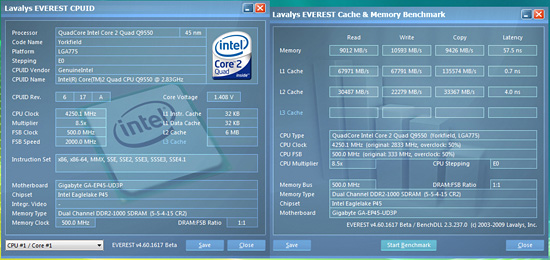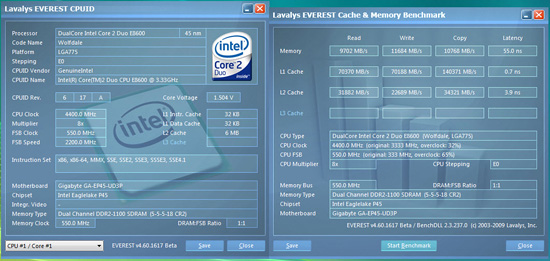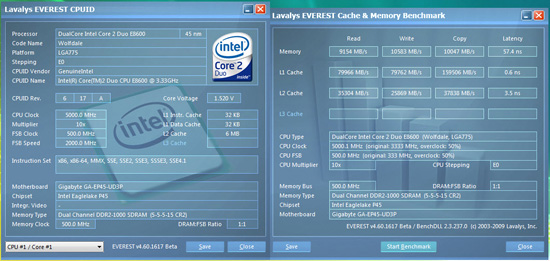Gigabyte GA-EP45-UD3P - P45 at its Finest
by Gary Key on February 3, 2009 12:15 AM EST- Posted in
- Motherboards
Overclocking
GIGABYTE advertises the GA-EP45-UD3P as a mainstream motherboard and will nudge users towards their enthusiast-oriented EP45 Extreme series or X48 boards for overclocking duties. We are here to say that is a big mistake based upon our results. We expected solid overclocking based on the BIOS design and board components, but this board clocked just as well or better than any upper-end P45 or X48 boards we have in the labs.
True, there are boards that might hit higher FSB rates or offer better memory performance, but we are concentrating on mainstream overclocking abilities in our tests. We focus on the type of overclocks that support 24/7 operation with reasonable cooling and the ability to run a multitude of programs without a problem. We are not optimizing for SuperPI or 3DMark records; it's more like trying to keep our bank records safe from a crash (sadly, there's nothing we can do about banks crashing).
We put an emphasis on stability during our testing sessions so we test with real world applications ranging from a variety of games to digital imaging software to various audio/video creation programs, along with the normal OCCT and PCMark Vantage tests.
Q9550 4GB Results

Our maximum overclock on air-cooling with the Q9550 resulted in a 4.25GHz clock speed at a respectable 500MHz FSB with our 4GB G.Skill memory kit set to DDR2-1000 at 5-5-4-15 timings. The primary voltages settings were 1.36V NB, 1.38V VTT, 1.70V PLL, 2.00V VDimm, and 1.425V for the CPU. We tried to run the memory higher, but could not get stability at the DDR2-1200 mark in Nero Recode or Crysis. Vdroop was approximately -.02V with Load Line Calibration (LLC) enabled and -.035V with it disabled at idle. Under load Vdroop was -.025V with LLC enabled and -.05V with it disabled.
Q9550 8GB Results

We were able to reach the same 8.5x500 for a 4.25GHz clock speed with 8GB at DDR2-1000 with 5-5-5-15 timings. However, our voltage settings changed to 1.38V NB, 1.40V VTT, 1.70V PLL, 2.06V VDimm, and 1.450V for the CPU to compensate for the additional load on the MCH. Under load Vdroop was -.02V with LLC enabled and -.05V with it disabled.
E8600 Results

Our maximum overclock on air-cooling with the E8600 came with a blistering 4.40GHz clock speed at a fully stable 550MHz FSB rate. Our 4GB G.Skill memory kit allowed us to reach DDR2-1100 at 5-5-5-18 settings. We used the following voltage settings: 1.40V NB, 1.36V VTT, 1.72V PLL, 2.08V VDimm, and 1.500V for the CPU. We had to drop to 8x500 to get 8GB stable while keeping VDimm below 2.1V, PLL below 1.80V, and NB below 1.50V. Vdroop was approximately -.01V with Load Line Calibration (LLC) enabled and -.025V with it disabled at idle. Under load Vdroop was -.02V with LLC enabled and -.04V with it disabled.
E8600 Additional Results

We knew we had a good E8600, so we pulled out our CoolIT Systems Freezone Elite kit and decided to see how far we could get on this board. We ended up at 5GHz with a 10x CPU multiplier and FSB set to 500. We installed 8GB of memory and ran it at DDR2-1000 with 5-5-5-15 timings. We used the following voltage settings: 1.42V NB, 1.40V VTT, 1.76V PLL, 2.04V VDimm, and 1.5675V (1.550V was stable after raising NB to 1.46V) for the CPU. This is the first time we have reached a stable 5GHz with this processor in a P45 board. Vdroop was similar to our results above.
Thoughts
We have absolutely no concerns about recommending this board for 24/7 500FSB+ use. This board overclocks quad-core chips just as easily as it does dual-core offerings, which is a feat that most P45 boards cannot accomplish. Depending on your processor choice, the Northbridge (MCH) and PLL voltages are two prime settings open for reduction. We only utilize retail processors so it is up to luck if we get a good processor or not for overclocking.
We ultimately ran our E8600 at 585FSB stable in all our applications except for Adobe Premier Pro 4.0; it would constantly hang at any FSB setting above 550. We also tried to verify GIGABYTE’s claim of DDR2-1366 support but our 2GB DDR2-1250 memory kit was unable to get above 1300. However, this is the first board that ran it stable at 1300 so we think it is just a limitation of our memory kit - or reluctance to push more than 2.4V into it.
In regards to voltage regulation, we think the GA-EP45-UD3P has excellent voltage output. We checked all the major voltages with a DMM and found very little variance between what you select in the BIOS and what the board actually outputs. The VTT, PLL, DIMM, and other voltages are accurate and stable across the spectrum. They show no real variances between idle and load states; if anything, we would see a small +.005V rise at times. As discussed, there is line droop on VCore when switching from idle to load situations. However, we found it was not substantial enough to affect stability or overclocking capabilities.
















73 Comments
View All Comments
NimitzHarrington - Monday, February 9, 2009 - link
Hi Gary,Excellent review. I'm glad I chose this board when I built my new system a couple of months back.
However, I have not managed to get eSata fully working on this board. When I plug in an eSata HDD, Vista picks it up but it's listed as an internal disk. Therefore, I cannot remove it from "Safely remove hardware".
I tried the latest Intel Storage Manager, but that did not help. I have had to resort to using HotSwap.
Have you come across this during your testing (or has anyone else using this MB experienced and fixed this issue)?
Thanks.
Lazlo Panaflex - Thursday, February 5, 2009 - link
An 8600 @ 5Ghz+...very nice o/c! I reckon that setup would fetch a pretty penny on Fleabay (unless Gary's using it as his main gaming rig...hehe ;)vlado08 - Wednesday, February 4, 2009 - link
I expected core i7 architecture to use less power than core2 Quad in "idle" mode because it can switch off unused cores. So if I have a computer which is 24/7 in "on" state then the best power efficiency will be to use core 2 Duo. For example if it is used for downloading/uploading from internet.It seems I was wrong. Or may be it is a Vista problem failing to switch off unused cores of core i7?
jzodda - Wednesday, February 4, 2009 - link
Have had it since october running my E8400@ 4.2ghz and 525 FSB 24/7This board is really a pleasure to work with once you get the hang of the various bios settings. Took awhile back then. Now there is an 1800 post thread at X-treme so info is no longer lacking on any setting.
This board is a throw back to the good old Abit days of the BH6 and boards like it. Lots of fun.
SixOfSeven - Tuesday, February 3, 2009 - link
LoneWolf15, what 4GB DDR2's are you using? Any problems setting things up?LoneWolf15 - Thursday, February 5, 2009 - link
"LoneWolf15, what 4GB DDR2's are you using? Any problems setting things up? "I apologize here. I used two 2GB modules, not two 4GB ones, and couldn't go back and re-edit.
I'm using G.Skill Pi DDR2-800 modules which work at 1.8-1.9v with 4-4-4-12 timing. They're available at the `Egg for $45-50 a set with free shipping, and they're hassle free. Almost tempting to get a second set for Windows 7 x64 when it comes out.
7Enigma - Wednesday, February 4, 2009 - link
Just wanted to add (even though you didn't ask) I'm using the 2X2gig Reaper ram that has the heatpipe with a huge heatsink on top (making the ram 2-3" taller than it would normally be). There are no clearance issues at all.Matt Campbell - Tuesday, February 3, 2009 - link
Time to break out the LN2 and see how far it really goes ;)Freak Out - Tuesday, February 3, 2009 - link
I was wondering if you could post a picture of the test setup?Gary Key - Wednesday, February 4, 2009 - link
Let me get one before I tear it down today.